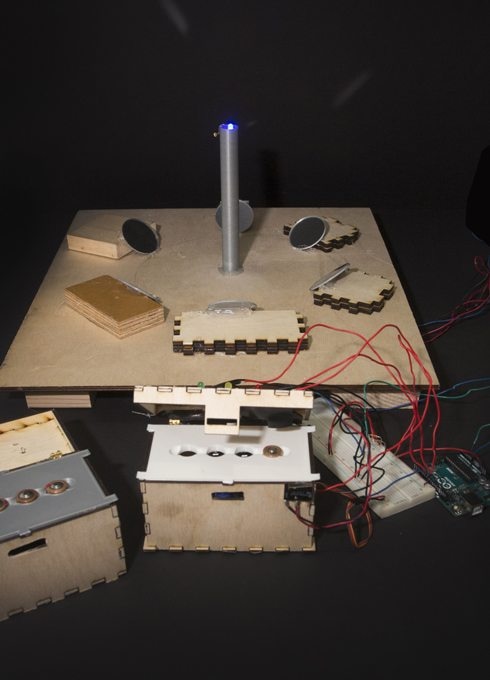May 3 2019
Camps and villages that are off the grid become more hazardous and tough to work at night without any light source. The 2019 Rothberg Catalyzer Impact-a-Thon at Carnegie Mellon University challenged student teams to develop lighting solutions for requisite areas, independent of electrical power grids.
 Selected Impact-aThon Prototypes (Image credit: Carnegie Mellon University)
Selected Impact-aThon Prototypes (Image credit: Carnegie Mellon University)
Over 15 teams enlisted to developed solutions including a range of technologies: batteries, solar power, kinetic energy from footfalls and weighted pulleys, and the blockchain were all covered. Each team produced a prototype and a poster presentation that elucidated how feasible their solution was with regards to cost of production, ease of manufacturing, and logistics for supplying the solution to affected areas.
The team that won first place was a group of Master of Integrated Innovation for Products & Services (MIIPS) students from the Integrated Innovation Institute. Vaibhav Gupta, Ranveer Katyal, Shawn Koid, and Taylor Mau developed Light Hub, a solar-driven charging station for four separate flashlights called Light Sticks. People can use the Light Sticks to see when they are away from a campsite. They also can rest assured while they are out: each time a Light Stick is taken from the charging station, a timer starts counting down. If the Light Stick is not returned within 15 minutes, it alerts the rest of the community that a camper could be in danger. The group was certain that each Light Hub could be made for $9.23. Each Light Stick can deliver up to 50 hours of light - more than adequate to keep refugees safe at night.
The second-place team was a group of students in the (MIIPS) program. Gaurav Asthana, Satyan Chawla, Cem Ergin, Karan Naik, Qicheng Yang, and Sisi Xi Yu created Sole-Tile, an economical, sustainable lighting solution that utilizes solar power as well. The Sole-Tile prototype is an assembly of 3D printed, handheld cubes that yield light and can be docked into a larger cube when they are not in use. The magnets on either side of each cube allow them to group together to develop a larger light or break apart to be used by persons going off alone into the dark, to go to the restroom at night for instance. The team appraised that each Sole-Tile unit could be manufactured in bulk and sold for around $5.
The third-place team comprised of Kunal Ashok, Tanvi Dhande, Steve Lin, Raghav Madan, and Omkar Powar, all of whom are master’s students in the Engineering & Technology Innovation Management (ETIM) Program. They developed something of a present-day campfire — a central meeting place that offers light, safety, and a sense of community. Their mobile solar hub is a transformed plastic storage bin used to house and recharge current lanterns found in the market. The team incorporated wheels and a handle to the container so it could be pulled along like a rolling suitcase, and they attached solar panels to the lid to gather energy. Within the container, solar lanterns can be recharged, drawing from the stored solar power that the hub gathers during the day. Besides supplying light, the lanterns have an alarm that a carrier can trigger in case of danger. The lantern will flash red, warning anyone nearby that the carrier requires help and will cause the hub to flash and sound off a loud buzzer.
All teams and guests liked a panel of specialists discussing "The Changing Landscape of Innovation" after the judging was completed. Experts included Jim Colliar (engineering director at CNH Industrial), Gautam Phanse (technology manager for energy materials & water at Chevron Technology Ventures), Lillian Rafson (CEO and founder of Pack Up & Go), and Jason Smith (assistant teaching professor and associate director for partnerships in the III). After the panel, the awards ceremony took place, where the top three teams received prizes of $1,000, $3,000, and $5,000. After the competition, a few team members may pursue patents or partner with groups like the United Nations Refugee Agency using their prize money.
The Rothberg Catalyzer Impact-a-Thon competition is supported by the College of Engineering and the Integrated Innovation Institute. It is sponsored by alumnus and university trustee Jonathan Rothberg, a 1985 graduate of the College of Engineering, who is the founder of several successful companies, including 454 Life Science, Hyperfine Research, Ion Torrent, Raindance Technologies, CuraGen, Butterfly Network Inc., LAM Therapeutics, and 4Catalyzer. He received the National Medal of Technology and Innovation for his revolutionary work on DNA sequencing, which impressively increased the efficiency and speed of genome analysis.
This year's Rothberg Catalyzer Impact-a-Thon challenged student teams to bring lighting solutions to areas that need it, independent of electrical power grids. (Credit: Carnegie Mellon University)